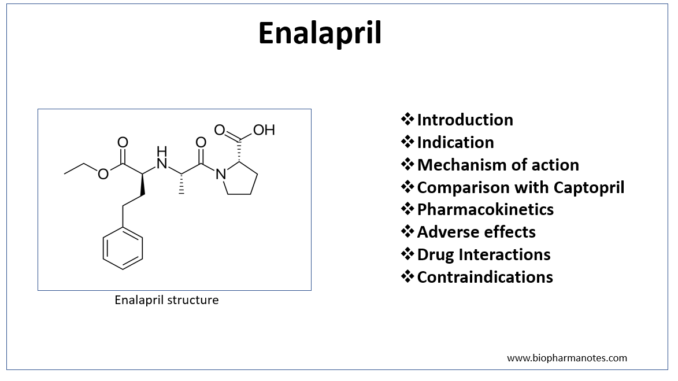
- Enalapril belongs to the class of ACEIs (Angiotensin Converting Enzyme inhibitors). It is second ACE inhibitor to be introduced in medical field after captopril. It is congener of captopril without an -SH group.
- Enalapril is included in World Health Organization’s List of Essential Medicines.
Indications of Enalapril
- Used to treat hypertension. It is used alone or in combination with other agents.
- To treat diabetic nephropathy as it slows its progression and decreases albuminuria.
- Used in symptomatic and asymptomatic CHF (Congestive Heart Failure) to decrease mortality and morbidity.
- Used in hypertensive emergencies.
- Some of its off-label indications include adult patients with
- ST-elevated myocardial infarction
- non- ST elevated acute coronary syndrome
- stable coronary artery disease
- post- transplant erythrocytosis
- proteinuric chronic kidney disease.
Mechanism of action of Enalapril

Figure- Mechanism of action of Enalapril
- It is a prodrug and is hydrolyzed by esterase in liver to active form enalaprilat. Enalaprilat is active dicarboxylic acid and is potent inhibitor of ACE (Angiotensin Converting Enzyme). Enalapril is weak inhibitor of ACE and enalaprilat is 10-20 times more potent than enalapril in ACE inhibition.
- ACE (angiotensin converting enzyme) cleaves inactive angiotensin I to active angiotensin II which is a potent vasoconstrictor. ACE is also involved in breakdown of bradykinin, a peptide that increases production of nitric oxide and prostacyclin, both of which are potent vasodilators.
- Enalaprilat competitively inhibits ACE and hence inhibit conversion of angiotensin I to angiotensin II. It results in prevention of:
- Pressor effect of angiotensin II.
- Stimulation of aldosterone synthesis and release resulting in decreased sodium and water retention.
- Metabolism of bradykinin by ACE.
- Thus, vasodilation of both arterioles and veins occur as a result of decreased vasoconstriction (due to decreased angiotensin II) and enhanced vasodilation (due to increased bradykinin).
Comparison with captopril
Some of its feature which differ it from captopril are:
- It is a prodrug and is converted to active metabolite enalaprilat.
- It is more potent than captopril. It’s absorption is not affected by food.
- As it should be converted to active form, its action is slower and lasts longer. Due to slow action, there is less chance of causing first dose hypotension.
- Less chances of rashes, loss of taste and glomerulopathy.
Pharmacokinetics of enalapril
- It is administered orally and shows good absorption after oral administration. Its oral bioavailability is 60% and is not affected by food. Also available as IV formulation. Volume of distribution is 1-2.4 L/kg.
- It is excreted either as enalapril or enalaprilat by kidneys. The half-life of enalapril is 1.3 hours and half-life of enalaprilat is 11 hours due to its tight binding with ACE.
Adverse effects
- Cough is the major side effect which is non- productive and stops once drug is discontinued. It is due to increased bradykinin which is often mild but may be troublesome.
- It may cause hypersensitivity, hypotension, angioedema and cholestatic jaundice. Hyperkalemia may occur (particularly in patients with renal insufficiency) so potassium level should be continuously monitored.
Drug Interactions
- Concurrent administration of drugs like aliskiren, nicorandil, heparin may increase chances of hyperkalemia. It can enhance administration of drugs like lithium, allopurinol, alteplase and sacubitril.
- Its hypotensive effect may be increased by concurrent administration of levodopa, alfuzosine, diazoxide and loop diuretics. Drugs like amphetamine and yohimbine can decrease its anti- hypertensive effect.
Contraindication
- It is contraindicated in patients with known hypersensitivity to enalapril.
- Contraindicated in following conditions:
- In patients with idiopathic angioedema, hereditary angioedema or history of angioedema with other ACE inhibitors.
- Pregnancy and lactation.
- In patients with severe bilateral renal artery stenosis.
- Contraindicated in patients with aortic stenosis and coarctation of the aorta.
References
- https://www.ncbi.nlm.nih.gov/books/NBK557708/
- xPharm: The Comprehensive Pharmacology Reference. 2007, Pages 1-6.
- A Practice of Anesthesia for Infants and Children (Sixth Edition). 2019, Pages 424-457.e17.
- A textbook of clinical pharmacology and therapeutics.
- Lippincott Illustrated Reviews Pharmacology, 6th edition.
- Pharmacology and pharmacotherapeutics. 24th edition.
- Goodman and Gillman Manual of Pharmacology and Therapeutics.